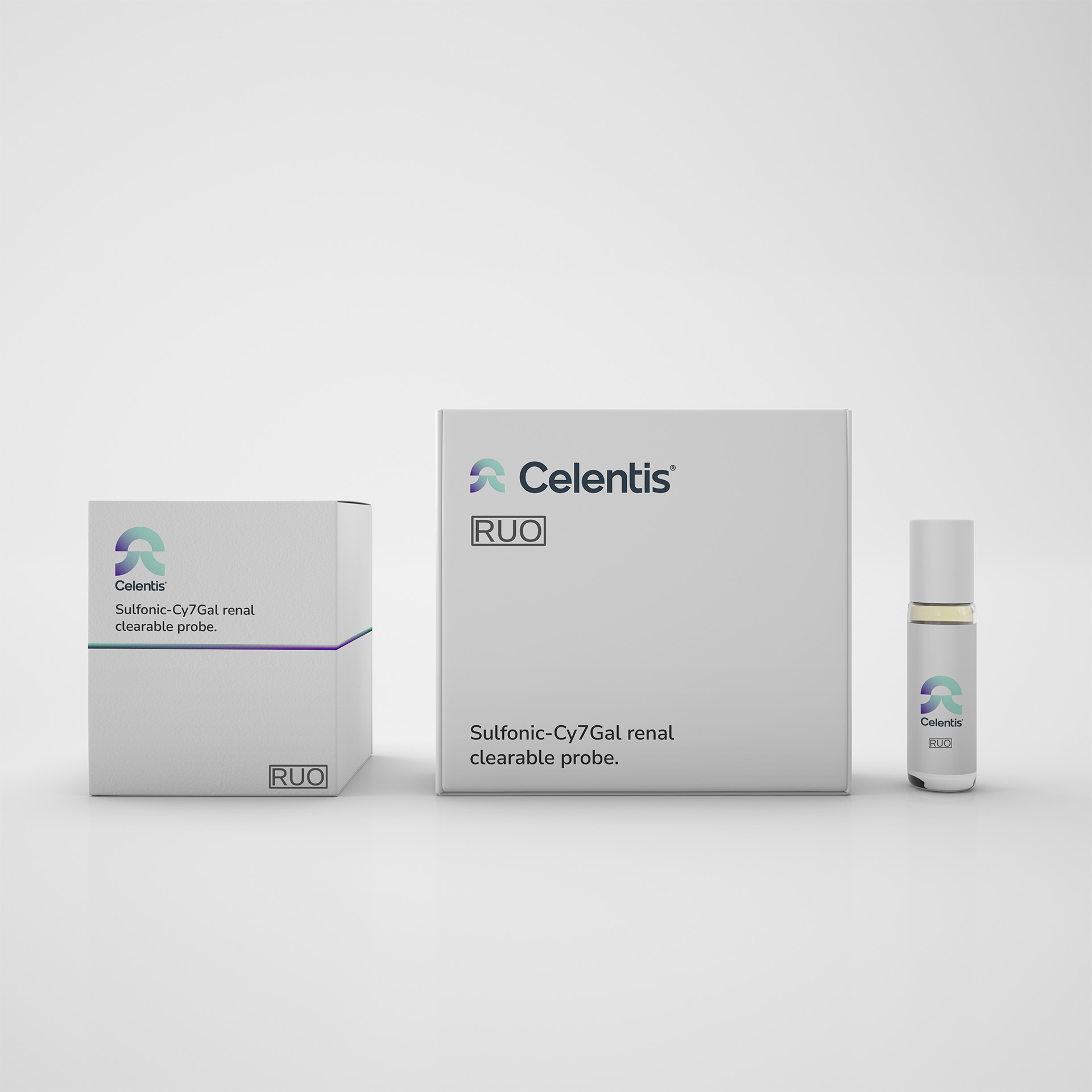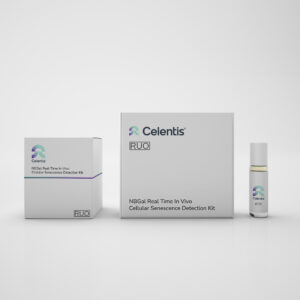Catalog No. CLT0001
Product information
Sulfonic-Cy7Gal is a substrate for β-galactosidase which releases a fluorophore when administered to mice containing senescent cells, and is ultimately excreted by the kidneys to be measured in urine. The intensity of the recovered fluorophore reliably reflects an experimentally controlled burden of cellular senescence. Unlike any other available β-Galactosidase probe, sulfonic-Cy7Gal provides an in vivo read-out of β-Gal activity in biofluids of both chemotherapy-induced cellular senescence and senolytic treatments –i.e elimination of senescent cells- mice models without the necessity of imaging techniques.
The probe can also be used as ex-vivo β-Gal assessment. The fluorescence intensity of sulfonic-Cy7 progressively rises in organs where the burden of senescent cells is experimentally increased. Sulfonic-Cy7Gal identifies organs with the highest β-Gal content in naturally aged mice.
Sulfonic-Cy7Gal probe is poorly fluorescent at 660 nm (λexc = 580 nm), releasing the highly fluorescent dye sulfonic-Cy7 after β-Gal hydrolysed.
Figure 1. Fluorescence emission spectra (λexc = 535 nm) of sulfonic-Cy7Gal (left) and sulfonic-Cy7 (right) in aqueous solutions.

| Product | Mw (g/mol) | Catalog No. | Amount | No. of mice | Storage* |
| Sulfonic-Cy7Gal | 1035.4 | CLT0001A | 4 vials x 25 mg | 10 | -20°C
Avoid freeze-thaw cycles Desiccate Protect from light |
| Sulfonic-Cy7 | 705.3 | CLT0001B | 1 vial x 2 mg | 0 | -20°C
Avoid freeze-thaw cycles Desiccate Protect from light |
| * When stored as directed, the product is stable for at least 6 months from the date receipt. | |||||
To prepare stock solutions
Sulfonic-Cy7Gal is provided as a lyophilized powder. For 100 μL injections prepare a 23.3 mg/mL solution dissolving the lyophilized powder in 1.087 mL of isotonic sterile saline solution (0.9% NaCl).
Sulfonic-Cy7 is provided as a lyophilized powder. Dissolve in DMSO at a 30 mM concentration. Prepare a 20X calibration curve in plasma or urine. Dilute the calibration curve to 1X in distilled water.
- Prepare the mice model as convenient. Sulfonic-Cy7Gal has been validated in the following strands:
| Strain | Age | Sex | Condition | Ex-vivo (Y/N) |
| BALB/cByJ | 28-34 weeks | Female | 4T1 orthotopic tumours + increasing doses of Palbociclib | Y |
| BALB/cByJ | 2 vs 14 months | Female/Male | Naturally aging | Y |
| C57BL/6 | 3 vs15 months | Male | Naturally aging | N |
| SAMR1 vs SAMP8 | 7 months | Male | Accelerated aging | N |
| SAMP8 | 7-12 months | Male | Dasatinib + Quercetin treatment | N |
| C57BL/6 | 15-18 months | Male | Dasatinib + Quercetin treatment | N |
-
- Anesthetised the by inhalation of 2% isoflurane and inject them intravenously (i.v.) or intraperitoneally (i.p.) with sulfonic-Cy7Gal (23.3 mg/mL; 100 µL). In cases of wide variation in weights, such as in ageing experiments, adjust the doses to the body weight of each animal (140 mg/kg, 200 μL). Note: Sulfonic-Cy7Gal working solutions should be used promptly. The concentration of Sulfonic-Cy7Gal should be optimised for different mice model and conditions
- Keep the mice anesthetised for 15 min.
- Upon awakening, collect urine samples individually in several Eppendorf tubes, the volume of micturition can vary between animals.
- Dilute the samples 1:20 in distilled water and measure them in a fluorimeter (λexc = 535 nm; λem = 560 nm) or in an in vivo imaging system (IVIS®, (λexc = 535 nm; λem = 640 nm; exposure time: 1 s). Note: the IVIS® filters and exposure time could change depending on the model, we recommend optimising it for each system.
- Measure the obtained urine volume with a pipette and calculate the amount of sulfonic-Cy7 fluorophore excreted in urine through a calibration curve.

- Nature Communications volume 15, Article number: 775 (2024)





Reviews
There are no reviews yet.